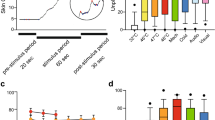Abstract
Objectives
The aim of this study was to evaluate the phenomenon of electrical skin resistance (ESR) changes at different acupuncture points (APs).
Setting
This single-blinded study was performed at the hospital of the University of Munich.
Design
Six common APs were measured (TE5, PC6, LU6, ST36, SP6, GB39) in 53 subjects. Subgroups were formed with varying time intervals for follow-ups (1 minute, 1 hour, 1 week) and a varying grade of reduction of the stratum corneum.
Methods
Electrical skin resistance measurements (ESRMs) were taken from a skin area of 6 x 6 cm using an array consisting of 64 (8 x 8) electrodes. The electrodes corresponding to the AP were located and the ESRM results were compared to those of the surrounding electrodes. The methodological setting made it possible to minimize major influence factors on electrical skin impedance measurements.
Results
A total of 631 ESRMs was evaluated: In 62.8 % of the measured APs, no significant ESR difference was found. In 234 (37.2 %) of the ESRMs, the ESR at the AP was significantly different from the surrounding skin area, with 163 (25.9 %) points showing a lower and 71 (11.3 %) points showing a higher ESR. Reproducibility was extremely high after 1 minute but was low after 1 hour and 1 week.
Conclusions
This study shows that electrical skin resistance at APs can either be lower or higher compared to the surrounding area. The phenomenon is characterized by high short-term and low long-term reproducibility.
Therefore, we conclude that APs might possess specific transient electrical properties. However, as the majority of the measured APs did not show a changed ESR, it cannot be concluded from our data that electrical skin resistance measurements can be used for acupuncture point localization or diagnostic/therapeutic purposes.
Similar content being viewed by others
Literatur
Ahn AC, Colbert AP, Anderson BJ, Martinsen OG, Hammerschlag R, Cina S, Wayne PM, Langevin HM. Electrical properties of acupuncture points and meridians: a systematic review. Bioelectromagnetics 2008;29(4):245–56
Wiegele B, Schober G, Kuder J, Kolb FP, Irnich D. A new sensor technique for measurements of electrical potential profiles of human skin at acupuncture points. Forsch Komplementmed 200613(4):227–32
Becker RO, Reichmanis M, Marino AA, Spadaro JA. Electrophysiological correlates of acupuncture points and meridians. Psychoenergetic Systems 1976 1:105–12
Author information
Authors and Affiliations
Corresponding author
Rights and permissions
About this article
Cite this article
Kramer, S., Winterhalter, K., Schober, G. et al. Characteristics of electrical skin resistance at acupuncture points in healthy humans. Dtsch Z Akupunkt 53, 43–44 (2010). https://doi.org/10.1016/j.dza.2010.01.025
Published:
Issue Date:
DOI: https://doi.org/10.1016/j.dza.2010.01.025




